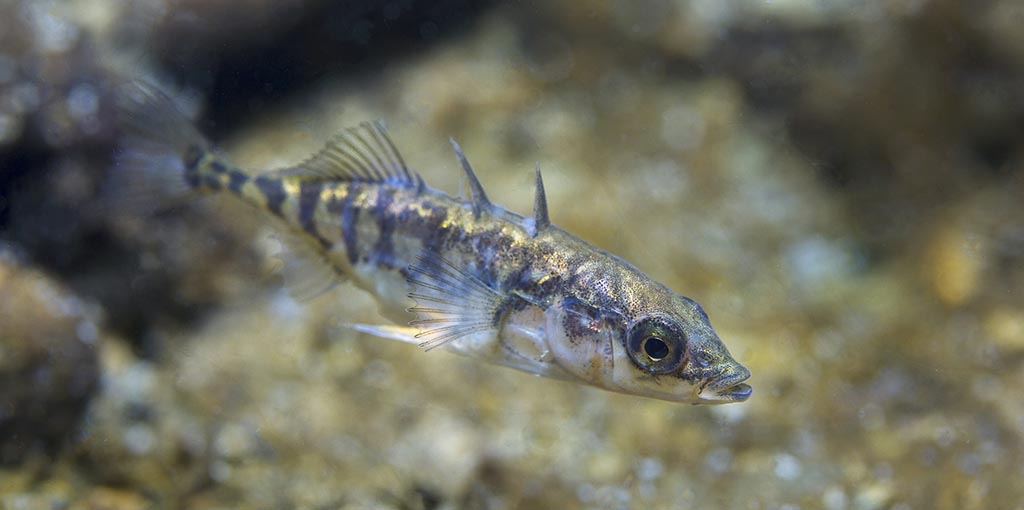Evolution. From grade school we are taught that an organism's ability to adapt to new environments was the result of a slow accumulation of countless random genetic mutations over decades or centuries -- some of which might happen to result in a particularly advantageous physical trait that makes that individual more reproductively ...
Are you bored yet? Never fear! Developmental biologist David Kingsley, PhD, and former graduate student Garrett Roberts Kingman, PhD, are here to shake things up.
Recently Kingsley and Roberts Kingman, with colleagues in the lab of Krishna Veeramah, PhD, lab at Stony Brook University and Michael Bell, PhD, at UC Berkeley, showed that, at least in some cases, evolution is less like a slog through molasses and more like a greased lightning skid to the finish line. Think "The Fast and the Furious" rather than the Slow TV classic Bergensbanen minutt for minutt.
The researchers studied a tiny fish called the threespine stickleback. But their discoveries are wide-ranging. They found that vastly different organisms, from the fish to Darwin's finches, have relied on similar genetic toolboxes to quickly and repeatedly adapt to new environmental challenges. They published their findings recently in Science Advances.
"We found that it doesn't take much longer for a stickleback to evolve than it does to complete a PhD thesis," Kingsley said. "They transform before your eyes, turning into freshwater fish within about five to seven years. This surprised a lot of people."
The marvelous stickleback
I've written before about the wonder of the threespine stickleback, which migrate from their primary ocean habitat up rivers to spawn in fresh water. Their unprepossessing looks hide a multitude of surprises.
To the uninitiated, the tiny threespine stickleback might look like nothing more than a scruffy anchovy with an attitude. But this tough little fish, with its characteristic finny mohawk, is a darling of evolutionary biologists.
That's because it exhibits some of the most recent, and most dramatic, adaptive changes of any animal alive today. Flourishing in fresh water or salty, appearing ponderously armored or slippery sleek, light-skinned or dark, this plucky pisces has made itself so uniquely at home in countless lakes, streams and oceans that early naturalists initially classified it as more than 50 separate species. It's the ultimate changeling.
These major physiological transformations are triggered when the fish colonize new freshwater lakes and rivers formed as glaciers recede. In response, the fish begin swapping their thick, armored seafaring bony plates for smaller, more flexible versions and shed a bony hind fin that could serve as a convenient handle for hungry fish-hunting insects.
These changes have happened countless times over millennia as each stranded population struggles to adapt.
This repeated arising of similar characteristics is an example of what's called recurrent evolution. But it wasn't clear how long these changes take, or exactly what kind of genetic machinations are required to go from a Superman of the sea to the Clark Kent of new post-glacial lakes.
As initial luck (followed by some clever planning) would have it, three self-contained Alaskan lakes provided a chance to watch the evolutionary process in action. Each had been treated to exterminate invasive species and improve recreational fishing -- one in the late 1980s and the others around 2010. Saltwater sticklebacks sneakily made their way into the first lake within the first few years after the extermination (likely from a neighboring slough).
In the early 1990s, Bell began taking annual samples of fish from the lake to track evolution's progress in real time, but they were missing the earliest stages of the fishes' transformation.
So, around 2010, the researchers restocked the other two lakes with about 3,000 saltwater sticklebacks to get a closer look at the first changes. They found that lightly armored fish began to appear in the lakes within two to three generations and, by 2017, they made up 20-30% of the total.
"We were sequencing the stickleback genomes every year to identify any regions that might be changing, and comparing the results in these young populations with that of the more established population from the first lake," Kingman said. "What genetic properties are changing to allow these fish to live successfully in fresh waters, and how is it happening with such incredible rapidity?"
A really, really good toolbox
The researchers found that each stickleback population relied on areas in the genome known as standing genetic variation, or SGV, which harbor alternative forms of genes that can be quickly conscripted in response to major environmental changes like a switch from salt water to fresh. In many of these regions, multiple genes important to a given adaptation are linked like tools on a tool belt.
"Instead of repeatedly inventing brand-new tools, the sticklebacks can reach into a set of existing tools that have been used over and over again in the past," Kingsley said. "When they grab onto these tools, they are off like a shot."
Many of the changes in the genes in the SGV aren't in the coding sequences of the genes themselves, but are instead concentrated in the neighboring regulatory regions that control when and where that gene is expressed.
"These pre-existing tools are not just good, they are really, really good tools that have been optimized over previous glacial periods," Roberts Kingman said. And that optimization is still going on, he explained. "We found that the parts of the genome that had the most tools clustered closest together underwent faster evolution than those that were more widely spread."
Although the most obvious transformation was the loss of the armored plates, Kingsley, Roberts Kingman and their colleagues found that about 15% of the fishes' genomes were rapidly changing.
"The whole fish is transforming," said Kingsley. "The plates are just the tip of the iceberg. We found that many genes are involved, but that these genes are part of a special set primed to facilitate rapid evolution."
Tree of life
Finally, the researchers compared what they had learned in the fish with other evolutionarily nimble species like Darwin's famed finches. The birds repeatedly and quickly adapt to changes in seed availability and type by modifying their beaks to maximize their munching ability during times of stress.
Roberts Kingman and Kingsley found that the areas of SGV they rely on to accomplish this transformation show similar patterns and characteristics to the stickleback tools. And they believe many other species may do so as well. Those who don't might face a tough time accommodating the variations in global temperature, water levels and urbanization on the horizon.
"It's such an exciting time. Scientists are sequencing more and more organisms. Soon we will be able to ask, 'What are the parts that matter most for evolution, and what does that mean for the ability to adapt to our changing planet?' When we first started our stickleback studies, some scientists thought we'd find a different answer in every lake," Kingsley said.
"But in fact we see that the same rules and the same tools are being used over and over again. Understanding this process is fundamental to our ability to predict how much of the tree of life will continue to exist during the coming decades and centuries."
Image by Rostislav




